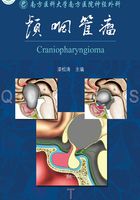
第三节 颅咽管瘤起源假说
从颅咽管瘤发现至今的100多年来,其先后被称为克拉克氏囊肿瘤、垂体管肿瘤、颅咽管囊肿瘤、Erdheim肿瘤、釉质瘤、表皮瘤、垂体柄肿瘤、髓样癌等。名称的改变反映了人们对该肿瘤的认识过程,而至今颅咽管瘤的起源尚有争论。目前,就其发生机制主要有以下三种学说较为可取。
一、源于颅咽管残留细胞
如前所述,在胚胎早期外胚层牙板附近处,口凹向内凹陷形成颅颊囊,它将形成以后的垂体前叶。之后,颅颊囊形成一囊泡,其与口凹之间由闭塞的颅咽管相连。颅颊囊细胞生长速度不同,前壁细胞生长迅速,压向颅底(以后的蝶鞍)后,即向前上旋转,并将已闭塞的颅咽管残余细胞带至新的部位,即垂体上方,甚至第三脑室前部(图2-10)。该学说认为,颅咽管瘤即起源于残余的颅咽管细胞。在我们的临床工作中,尤其是在对于鞍膈下颅咽管瘤的手术中,通常在肿瘤全切除后,能在垂体窝的底部见到一个小孔(图2-11),这是对颅咽管瘤从残余的颅咽管细胞起源的最好证据。




图2-10 颅咽管瘤起源机制示意图
a.胚胎发生早期,口凹内陷形成颅颊囊;b.颅颊囊进一步内陷和封闭,形成一囊泡,以闭塞的颅咽管与口凹外胚层相连;c颅颊囊在发育为垂体前叶过程中,前下部细胞增生较快,并且整个生长过程为一旋转过程,腹侧的细胞最后构成垂体结节部;d.因前下部细胞大量增生,达鞍底后继而向上旋转,从而将闭塞的颅咽管的残余细胞带向鞍上。颅咽管瘤可能源于这种颅咽管残余细胞。间脑向尾侧凹陷,形成垂体后叶。另外垂体前叶内残留的未分化的颅颊囊细胞也可能是颅咽管瘤的来源;①颅咽管细胞;②颅颊囊细胞;③间脑;④牙板;⑤垂体前叶结节部;⑥垂体前叶中间部;⑦垂体前叶远侧部;⑧漏斗柄;⑨垂体后叶神经部;⑩残余的颅咽管细胞; ⑪蝶鞍
修改自Sartoretti-Schefer S,Wichmann W,Aguzzi A,Valavanis A:MR differentiation of adamantinous and squamous-papillary craniopharyngiomas.AJNR Am J Neuroradiol 18:77-87,1997.








图2-11 1例鞍膈下颅咽管瘤
a~c.CT和MRI扫描,1例22岁女性患者,鞍内鞍上占位,以囊性为主,但鞍内有明显钙化;d~e.前纵裂入路切除肿瘤;f.肿瘤全切后,可见一小孔(黑色箭头)位于垂体窝的底部(其放大图见图g),这一小孔可能暗示了鞍膈下颅咽管瘤的起源;h.肿瘤全切后,一块人工硬膜用来修补鞍膈缺损
根据前面垂体发生过程的描述(图2-9),我们可以发现,颅咽管瘤残余细胞存在于从口咽部到三脑室之间的任何位置,该学说也解释了鼻咽部颅咽管瘤、源于蝶骨的颅咽管瘤和三脑室内颅咽管瘤的发生;同时该学说认为,肿瘤和胚胎时期口凹与牙板所在部位关系十分密切,而牙板将形成牙齿的釉质器,这样也就解释了颌部牙釉质细胞癌、角质化,以及钙化性齿源囊肿和牙釉质型颅咽管瘤在组织学上甚为相似的原因;另外,有文献报道颅咽管瘤内曾发现有牙齿的存在。
二、源于颅颊囊的残余细胞
Goldberg和Eshbaugh在对新生儿垂体进行研究时,发现在4例新生儿的腺垂体结节部有鳞状上皮细胞巢,他们认为这些鳞状上皮细胞是颅颊囊的残迹,并认为大多数新生儿垂体内这些残迹消失,是由于颅颊囊细胞分化完全造成的。目前也有很多研究支持颅咽管瘤即来源于颅颊囊残余的鳞状上皮的学说,并认为这些残余细胞以结节部为最多,同时也认为肿瘤的位置和胚胎期鞍区的发育过程有关。文章认为,来源于中胚层的软脑膜结缔组织正常是在妊娠第5周,垂体结节部旋转之前插入到颅颊囊和脑泡之间的,这样残余的拉克囊细胞就不可能位于软膜下。而腺垂体和神经垂体之间的软膜,也就最终演变成为二者之间的薄层结缔组织分隔。但是如果该结缔组织延迟生长,这些拉克囊就会直接和脑泡相接触,并可能会残余一些拉克囊细胞在脑泡上,这些细胞可能就是三脑室内肿瘤的发生来源(图2-12)。


图2-12 胚胎发育过程中软膜延迟发育,所造成肿瘤的位置不同,即颅咽管瘤起源学说2
a.软脑膜正常插入颅颊囊和脑泡之间;b.正常发育,软脑膜下无残余原始细胞;c.软脑膜延迟发育,并造成颅颊囊和脑泡;d.最终造成软脑膜下有残直接接触余的颅咽管细胞和颅颊囊细胞
究竟有没有原发于三脑室内的颅咽管瘤,目前争论颇多,且没有确实可靠的证据证明其存在,根据上面的示意图,似乎残余的胚胎上皮细胞可以直接和间脑神经外胚层发生关系;但根据胚胎发育的特性,理论上这些残余口凹来源的上皮细胞,是无法穿过神经外胚层而进入三脑室内,进而形成原发三脑室内肿瘤的;因此累及三脑室的T型颅咽管瘤真实的解剖部位应该定位于三脑室壁的神经组织和软脑膜之间,对于这点笔者在讨论中还有叙述。
有学者对于颅咽管瘤囊腔内衬上皮所分泌的黏液进行研究,发现它们的成分与口咽黏膜所分泌的黏液成分类似,提示颅咽管瘤确实和颅颊囊有关。另外,Tachibana O等人发现,垂体前叶结节部、颅颊囊和颅咽管瘤均能产生P-糖蛋白,也提示它们有一个共同的胚胎外胚层起源。关于单纯的三脑室内肿瘤的一系列报道,都描述除了漏斗和灰结节外,其他脑室各壁均保持完整,这点也支持了本学说。
三、细胞化生学说
正如前面所说,颅颊囊发育成腺垂体的各个部分,在对垂体的组织细胞学研究中,很多学者发现结节部中存在有鳞状上皮细胞,特别是在成人更是常常发现鳞状上皮巢。另外,发现垂体前叶结节部的鳞状上皮细胞巢内和其周围含有促性腺激素和促皮质激素颗粒,从而他们也推测这些鳞状上皮细胞是由垂体前叶中正常的具有分泌功能的细胞分化而来,并认为颅咽管瘤,特别是鳞状乳头型,可能就来源于这种化生的鳞状上皮。Goldberg和Eshbaugh回顾研究了1364例腺垂体,在其中78例年龄<10岁的病例中,并没有发现明确的鳞状上皮细胞巢,故他们认为这些鳞状细胞并非胚胎期颅颊囊残余,而是由正常细胞分化而来的。他们也发现这些鳞状细胞巢罕见于20岁以下患者,并随着年龄增加这种化生渐渐增多。
目前,对于颅咽管瘤的免疫组化和电镜检查,也都可以显示出各种垂体前叶的激素,并且垂体前叶、垂体腺瘤和颅咽管瘤均能产生人类绒毛膜促性腺激素。这些也都符合细胞化生学说的描述。
随着对颅咽管瘤认识的深入,发现临床上颅咽管瘤的生物学特性差异较大,儿童和成人该肿瘤的特点也有很大的不同。故也有不少学者提出了多元论的学说。在临床上,颅咽管瘤发病率有两个高峰,第一个高峰是5~10岁的儿童,另外一个高峰发生在40~60岁。也就是说,在儿童和成年人都会出现发病高峰,而儿童颅咽管瘤多以釉质细胞型为主,钙化多见,且囊变部分常较大;成人肿瘤多以鳞状乳头型为主,钙化少见,囊变区较小。由此,有学者认为,儿童颅咽管瘤多来源于颅咽管残留细胞,而成人肿瘤多来源于细胞化生的鳞状上皮细胞岛。
参考文献
1.Akimura T,Kameda H,Abiko S,Aoki H,et al.Infrasellar craniopharyngioma.Neuroradiology.1989,31(2):180-183.
2.Alvarez-Garijo JA,Froufe A,Taboada D,et al.Successful surgical treatment of an odontogenic ossified craniopharyngioma.Case report.J Neurosurg.1981,55(5):832-835.
3.Asa SL,Kovacs K,Bilbao JM.The pars tuberalis of the human pituitary.A histologic,immunohistochemical,ultrastructural and immunoelectron microscopic analysis.Virchows Arch A Pathol Anat Histopathol.1983,399(1):49-59.
4.Banna M.Craniopharyngioma:based on 160 cases.Br J Radiol.1976,49(579):206-223.
5.Benitez WI,Sartor KJ,Angtuaco EJ.Craniopharyngioma presenting as a nasopharyngeal mass:CT and MR findings.J Comput Assist Tomogr.1988,12(6):1068-1072.
6.Brewer DB.Congenital absence of the pituitary gland and its consequences.J Pathol Bacteriol.1957,59-67.
7.Burger PC,Fuller GN.Pathology—trends and pitfalls in histologic diagnosis,immunopathology,and applications of oncogene research.Neurol Clin.1991,9(2):249-271.
8.Byrne MN,Sessions DG.Nasopharyngeal craniopharyngioma.Case report and literature review.Ann Otol Rhinol Laryngol.1990,99(8):633-639.
9.Chi JG,Lee MH.Anatomical observations of the development of the pituitary capsule.J Neurosurg.1980,52(5):667-670.
10.Ciric I.On the origin and nature of the pituitary gland capsule.J Neurosurg.1977,46(5):596-600.
11.Conklin JL.The development of the human fetal adenohypophysis.Anat Rec.1968,160(1):79-91.
12.Cooper PR,Ransohoff J.Craniopharyngioma originating in the sphenoid bone.Case report.J Neurosurg.1972,36(1):102-106.
13.Dietemann JL,Kehrli P,Maillot C,et al.Is there a dural wall between the cavernous sinus and the pituitary fossa?Anatomical and MRI findings.Neuroradiology.1998,40(10):627-630.
14.GB W.The meningeal relations of the hypophysis cerebi:PartⅠ-The relations in adult mammals.Anat Rec.1937:273-279.
15.GB W.The meningeal relations of the hypophysis cerebi:PartⅡ-An embryological study of the meniges and blood vessels of the human hypophysis.Am J Anat.1937:95-130.
16.GOLDBERG GM,ESHBAUGH DE.Squamous cell nests of the pituitary gland as related to the origin of craniopharyngiomas.A study of their presence in the newborn and infants up to age four.Arch Pathol.1960,70:293-299.
17.GORLIN RJ,PINDBORG JJ,REDMAN RS,WILLIAMSON JJ,HANSEN LS:The calcifying odontogenic cyst.a new entity and possible analogue of the cutaneous calcifying epithelioma of malherbe.Cancer.1964,17:723-729.
18.Graziani N,Donnet A,Bugha TN,et al.Ectopic basisphenoidal craniopharyngioma:case report and review of the literature.Neurosurgery.1994,34(2):346-349,discussion 349.
19.Hillman TH,Peyster RG,Hoover ED,et al.Infrasellar craniopharyngioma:CT and MR studies.J Comput Assist Tomogr.1988,12(4):702-704.
20.Iwasaki K,Kondo A,Takahashi JB,et al.Intraventricular craniopharyngioma:report of two cases and review of the literature.Surg Neurol.1992,38(4):294-301.
21.Julow J,Lanyi F,Hajda M,et al.Intracystic instillation of yttrium 90 silicate colloid in cystic craniopharyngioma.Orv Hetil.1989,130(26):1367-1368,1371-1375.
22.Kalnins V.Calcification and amelogenesis in craniopharyngiomas.Oral Surg Oral Med Oral Pathol.1971,31(3):366-379.
23.Kanungo N,Just N,Black M,et al.Nasopharyngeal craniopharyngioma in an unusual location.AJNR Am J Neuroradiol.1995,16(6):1372-1374.
24.Krsulovic J,Bruckner G.Morphological characteristics of pituicytes in different functional stages.Light-and electronmicroscopy of the neurohypophysis of the albino rat.Z Zellforsch Mikrosk Anat.1969,99(2):210-220.
25.LUSE SA,KERNOHAN JW.Squamous-cell nests of the pituitary gland.Cancer.1955,8(3):623-628.
26.Mastronardi L,Guiducci A.Are nonfunctioning pituitary adenomas extending into the cavernous sinus aggressive and/or invasive?Neurosurgery.2002,51(2):521-522,author reply 522.
27.Mukada K,Mori S,Matsumura S,et al.Infrasellar craniopharyngioma.Surg Neurol.1984,21(6):565-571.
28.Parkinson D.Surgical anatomy of the lateral sellar compartment(cavernous sinus).Clin Neurosurg.1990,36:219-239.
29.Petito CK.Craniopharyngioma:prognostic importance of histologic features.AJNR Am J Neuroradiol.1996,17(8):1441-1442.
30.Sartoretti-Schefer S,Wichmann W,Aguzzi A,et al.MR differentiation of adamantinous and squamous-papillary craniopharyngiomas.AJNR Am J Neuroradiol.1997,18(1):77-87.
31.Sener RN.Giant craniopharyngioma extending to the anterior cranial fossa and nasopharynx.AJR Am J Roentgenol.1994,162(2):441-442.
32.Songtao Q,Yuntao L,Jun P,et al.Membranous layers of the pituitary gland:histological anatomic study and related clinical issues.Neurosurgery.2009,64(3 suppl):s1-s9,discussion s9-s10.
33.Sunderland S.The meningeal relations of the human hypophysis cerebri.J Anat.1945,79(Pt 1):33-37.
34.Szeifert GT,Pasztor E.Could craniopharyngiomas produce pituitary hormones?Neurol Res.1993,15(1):68-69.
35.Tachibana O,Yamashima T,Yamashita J,et al.Immunohistochemical expression of human chorionic gonadotropin and P-glycoprotein in human pituitary glands and craniopharyngiomas.J Neurosurg.1994,80(1):79-84.
36.Taptas JN.The so-called cavernous sinus:a review of the controversy and its implications for neurosurgeons.Neurosurgery.1982,11(5):712-717.
37.Teramoto A,Hirakawa K,Sanno N,et al.Incidental pituitary lesions in 1,000 unselected autopsy specimens.Radiology.1994,193(1):161-164.
38.Wang Y,Zhao C,Wang Z,et al.Apoptosis of supraoptic AVP neurons is involved in the development of central diabetes insipidus after hypophysectomy in rats.BMC Neurosci.2008,9:54.
39.Yokoyama S,Hirano H,Moroki K,et al.Are nonfunctioning pituitary adenomas extending into the cavernous sinus aggressive and/or invasive?Neurosurgery.2001,49(4):857-862,discussion 862-863.
40.黄传平,漆松涛.颅咽管瘤与生长激素缺乏.国外医学神经病学神经外科学分册.2003,30(4):359-362.
41.刘保国,漆松涛,潘军,等.颅咽管瘤组织炎症的研究及意义.广东医学.2006,27(1):61-63.
42.王永谦,丁美修,谭多盛,等.垂体囊的胚胎发育和显微解剖研究.中国临床解剖学杂志.2005,23(2):137-141.